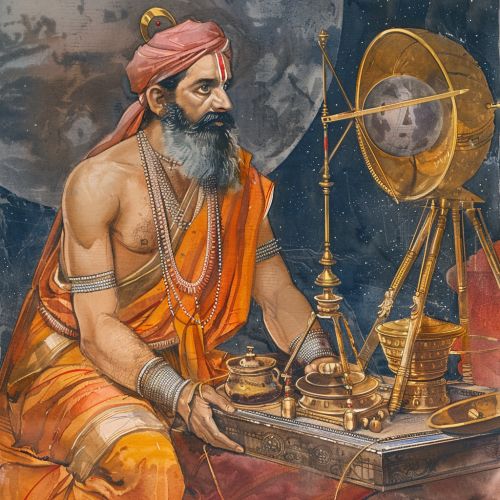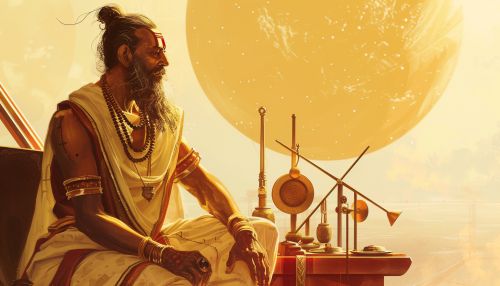Indian astronomy: Difference between revisions
(Created page with "== Introduction == Indian astronomy is a rich and complex field that has evolved over millennia, deeply intertwined with the cultural, religious, and scientific history of the Indian subcontinent. This article delves into the historical development, key figures, major texts, and significant contributions of Indian astronomy. It also explores the astronomical concepts and techniques developed in India, their influence on other cultures, and the modern revival and continu...") |
No edit summary |
||
| Line 17: | Line 17: | ||
The classical period of Indian astronomy began around the 5th century CE with the works of [[Aryabhata]], one of the most renowned Indian astronomers and mathematicians. Aryabhata's seminal work, the [[Aryabhatiya]], introduced several groundbreaking concepts, including the [[heliocentric model]] of the solar system, the calculation of the [[circumference of the Earth]], and the concept of [[sine]] in trigonometry. | The classical period of Indian astronomy began around the 5th century CE with the works of [[Aryabhata]], one of the most renowned Indian astronomers and mathematicians. Aryabhata's seminal work, the [[Aryabhatiya]], introduced several groundbreaking concepts, including the [[heliocentric model]] of the solar system, the calculation of the [[circumference of the Earth]], and the concept of [[sine]] in trigonometry. | ||
[[Image:Detail-91679.jpg|thumb|center|Illustration of Aryabhata, an ancient Indian astronomer and mathematician, sitting with astronomical instruments.|class=only_on_mobile]] | |||
[[Image:Detail-91680.jpg|thumb|center|Illustration of Aryabhata, an ancient Indian astronomer and mathematician, sitting with astronomical instruments.|class=only_on_desktop]] | |||
Other notable astronomers from this period include [[Varahamihira]], who authored the [[Brihat Samhita]] and the [[Pancha-Siddhantika]], and [[Brahmagupta]], known for his work [[Brahmasphutasiddhanta]]. These texts covered a wide range of topics, including planetary motions, eclipses, and the calculation of time. | Other notable astronomers from this period include [[Varahamihira]], who authored the [[Brihat Samhita]] and the [[Pancha-Siddhantika]], and [[Brahmagupta]], known for his work [[Brahmasphutasiddhanta]]. These texts covered a wide range of topics, including planetary motions, eclipses, and the calculation of time. | ||
Latest revision as of 04:01, 20 June 2024
Introduction
Indian astronomy is a rich and complex field that has evolved over millennia, deeply intertwined with the cultural, religious, and scientific history of the Indian subcontinent. This article delves into the historical development, key figures, major texts, and significant contributions of Indian astronomy. It also explores the astronomical concepts and techniques developed in India, their influence on other cultures, and the modern revival and continuation of these traditions.
Historical Development
Vedic Period
The roots of Indian astronomy can be traced back to the Vedic period (1500–500 BCE). The Vedas, ancient sacred texts of India, contain numerous references to astronomical phenomena. The Rigveda mentions the nakshatras (lunar mansions) and the solstices. The Yajurveda provides details on the ecliptic and the zodiac.
Vedanga Jyotisha
The Vedanga Jyotisha, composed around 1200 BCE, is one of the earliest known Indian texts dedicated to astronomy. It is part of the Vedanga, a set of six auxiliary disciplines associated with the study and understanding of the Vedas. The Vedanga Jyotisha focuses on the timing of rituals and provides detailed instructions on the calculation of the positions of celestial bodies.
Classical Period
The classical period of Indian astronomy began around the 5th century CE with the works of Aryabhata, one of the most renowned Indian astronomers and mathematicians. Aryabhata's seminal work, the Aryabhatiya, introduced several groundbreaking concepts, including the heliocentric model of the solar system, the calculation of the circumference of the Earth, and the concept of sine in trigonometry.


Other notable astronomers from this period include Varahamihira, who authored the Brihat Samhita and the Pancha-Siddhantika, and Brahmagupta, known for his work Brahmasphutasiddhanta. These texts covered a wide range of topics, including planetary motions, eclipses, and the calculation of time.
Medieval Period
During the medieval period, Indian astronomy continued to flourish with the contributions of scholars such as Bhaskara I, Bhaskara II, and Madhava of Sangamagrama. Bhaskara II's work, the Siddhanta Shiromani, is particularly notable for its detailed treatment of trigonometry, algebra, and calculus.
The Kerala School of Astronomy and Mathematics, active from the 14th to the 16th centuries, made significant advances in infinite series and calculus, predating similar developments in Europe by several centuries. Madhava of Sangamagrama, a key figure of this school, is credited with the discovery of the Madhava-Leibniz series for π (pi).
Key Concepts and Techniques
Nakshatras
The concept of nakshatras or lunar mansions is central to Indian astronomy. The sky is divided into 27 or 28 nakshatras, each associated with a specific star or group of stars. These nakshatras are used to track the movement of the Moon and to determine auspicious times for rituals and ceremonies.
Panchanga
The Panchanga is a traditional Hindu calendar that combines both solar and lunar elements. It provides detailed information on tithi (lunar day), vara (weekday), nakshatra, yoga (a specific combination of the Sun and Moon), and karana (half of a tithi). The Panchanga is used for determining the timing of religious festivals, rituals, and other important events.
Siddhantas
The Siddhantas are a genre of astronomical texts that provide comprehensive mathematical and observational techniques for calculating the positions of celestial bodies. The five major Siddhantas are the Surya Siddhanta, Paulisa Siddhanta, Romaka Siddhanta, Vasishta Siddhanta, and Paitamaha Siddhanta. These texts form the foundation of classical Indian astronomy and have been extensively studied and commented upon by later scholars.
Instruments
Indian astronomers developed a variety of instruments for observing and measuring celestial phenomena. The gnomon (shanku) was used to determine the altitude of the Sun and to calculate the time of day. The armillary sphere (golayantra) was employed to model the celestial sphere and to track the positions of stars and planets. The astrolabe (yantra) was another important instrument, used for solving problems related to time and the position of celestial bodies.
Influence on Other Cultures
Indian astronomy had a profound influence on the development of Islamic astronomy. During the 8th and 9th centuries, Indian astronomical texts were translated into Arabic, and Indian techniques and concepts were integrated into Islamic astronomical works. The Surya Siddhanta and the Brahmasphutasiddhanta were particularly influential in this regard.
The transmission of Indian astronomical knowledge to the Islamic world also facilitated its spread to Europe. The works of Indian astronomers were studied and referenced by European scholars during the Renaissance, contributing to the development of modern astronomy.
Modern Revival
In the 19th and 20th centuries, there was a renewed interest in traditional Indian astronomy, driven by both Indian and Western scholars. The establishment of institutions such as the Indian Institute of Astrophysics and the Aryabhatta Research Institute of Observational Sciences has played a crucial role in the revival and continuation of Indian astronomical traditions.
Contemporary Indian astronomers continue to draw inspiration from the rich heritage of their predecessors while contributing to the global advancement of astronomical knowledge. The Indian Space Research Organisation (ISRO) has also made significant strides in space exploration, further cementing India's position in the field of astronomy.
